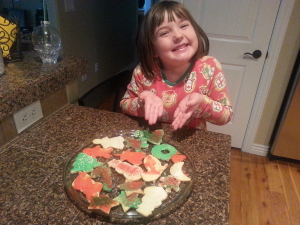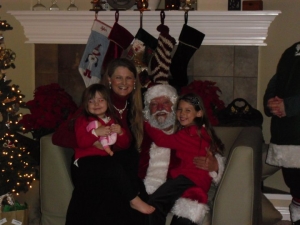 Christmas used to be so simple. My girls would compose and illustrate their letters to the North Pole in their very best flowery handwriting and colorful artistry they could muster – giving Santa great ideas of what to look for in the children’s aisles. “Santa” would find a bunch of toys, games and stuffed animals and put them under the tree and the kids were delighted on Christmas morning. Sigh. If only it were still as easy.
Christmas used to be so simple. My girls would compose and illustrate their letters to the North Pole in their very best flowery handwriting and colorful artistry they could muster – giving Santa great ideas of what to look for in the children’s aisles. “Santa” would find a bunch of toys, games and stuffed animals and put them under the tree and the kids were delighted on Christmas morning. Sigh. If only it were still as easy.
It all gets more and more complicated every year. What makes it so tricky? One sister is 14 – the other is 8 – and the age of Santa Claus is sadly coming to a close.
The teenager has known “the truth” for a few years now – and has been marvelous at playing along for the sake of her younger sibling. But, just like she had to be coerced into dressing up for Halloween and opted to not have an actual themed birthday party this year, she’s not easily convinced of the necessity to sit down and write that letter to Ol’ Saint Nick with her sister.
On one hand, it breaks my heart, but on the other hand, I get it. What 14 year old writes letters to Santa anymore? Does he have an iPhone 6s on his toy shelf, accompanied with a $100 iTunes gift card, sitting right next to the Barbie Dream House and Frozen Ice Castle that are on the 8-year-old’s wish list?
Intellectually, I always knew the age difference between my daughters would reach a tipping point someday, but emotionally, I’m not ready for it.
A 6-year-old is delighted to have a “baby sister” with whom to cuddle and coo. A 7-year-old is not remotely disturbed by a 1-year-old’s night-time crying. An 8-year-old will still sit and play dolls with a 2-year-old. It’s starting to be a stretch, but a 9-year-old will still laugh and run around outside in the backyard with a 3-year-old. A 10-year-old will pretend to be a school teacher with a 4-year-old starting to learn letters and numbers, but big sister gets impatient quickly. An 11-year-old will read a bedtime story to a 5-year-old, maybe once, but not repeatedly. A 12-year-old will let her friends who come over say hello to her little sister, but then the pre-teen goes to her room and shuts the door, leaving the 6-year-old to wonder what she did wrong. A 13-year-old will help her 7-year-old sister spell the words right on her letter to Santa, but it’s officially the little sister’s responsibility to put out the cookies and milk.
This year, while the “secret is still safe” – the truth is, the 14-year-old is more interested in her tracking down friends on her new Instagram account than she is in decorating the tree, while the 8-year-old wants to unpack and place every ornament that she possibly can.
Of course, there’s no real anger or disappointment on the little sister’s part. And, there is no animosity in any of it on the teenager’s part. They really do get along wonderfully well – I’m very blessed by how much they love each other and DO “play” together nicely (most of the time.) It’s just “the age” and with maturing comes new and different interests. It doesn’t mean my teenager doesn’t love or appreciate “Santa” and his gifts. It only means she’s growing up, and her sister will too in the coming years, and watching for a sleigh and reindeer will take a back seat to something else.
Heavy sigh.
I suppose it’s simply a rite of passage we all experience, once as a child, and now apparently, again as an adult. The age of Santa Claus seems to be influenced by our chronological age, in which the older we get, the less time we have to play. But why does it have to be that way? Why can’t we keep our childlike beliefs?
Who says we have to “grow up” and “be responsible” ALL the time? What’s wrong with playing like little kids even as we’re young adults or “older” people?
I, for one, still love when “Santa” comes to town… even if he has a Smart Phone Case in the same big black bag as the Inside Out Emotion Control Console. Christmas can still be simple, if we let it be. In my opinion, the true age of Santa Claus is whatever we allow it to be.
Soft smiling sigh.


